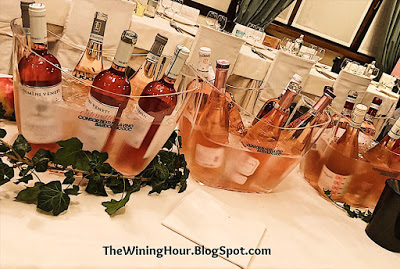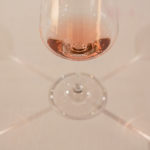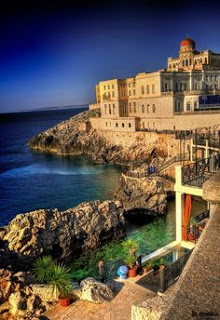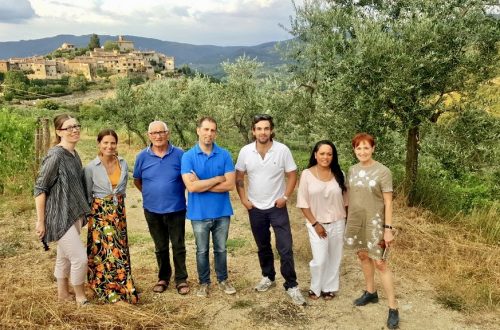The Lake Effect: Lake Garda’s Impact on Chiaretto
Chiaretto, a Product of its Terroir
About Chiaretto
Chiaretto another Italian varietal that is on the rise and will surprise. Chiaretto (key-ar-et-toh) is a very pale, crisp, dry rosé wine produced around Lake Garda, which is about 30 minutes from beautiful Verona, in Northern Italy. Its production spans the provinces of Verona in the region of Veneto and Brescia in Lombardy. Chiaretto’s origins date back to the 19th century and the Chiaretto DOC was created by Pompeo Molmenti in 1896, who applied what he learned about rosé vinification in France. In Italian, the name Chiaretto is derived from “chiaro,” which means light or pale, and the process of making Chiaretto, like other rosés, involves limiting the juices’ exposure to the grape’s skins, resulting in Chiaretto’s pale pink color. There are two sides to Chiaretto: Chiaretto di Bardolino and Valténesi Chiaretto.
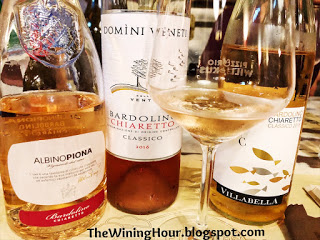 |
| Excellent Chiaratto’s Azienda Albino Piona, Domini Veneto and Vignete Villabella |
Chiaretto di Bardolino, produced on the east side of Lake Garda in Veneto, is made primarily from Corvina grapes, although it often includes Rondinella and Molinara. Corvina is yet another indigenous Italian grape varietal, as Italy has over 430 grapes. Corvina is known to yield wines with crisp acidity, minerality, medium body and fine, light tannins (although it can also yield much more, as it is also a grape used for Ripasso and Amarone). Its profile includes a range of aromas from floral to herbaceous and/or citrus fruits to spicy berries, while the palate is young, fresh and vibrant. Bardolino produces both the Chiaretto rosé, as well as a Bardolino rosso. Visit Chiaretto Pink by the Consorzio Tutela Vino Bardolino DOC for more information about Chiaretto di Bardolino.
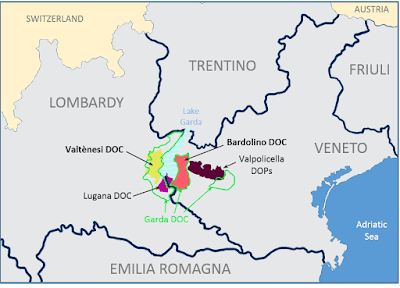 |
| Map of Lake Garda DOC’s Photo Credit: Consorzio Valténesi |
Valtenési Chiaretto, which is produced on the western side of Lake Garda in Lombardy, extends upwards to the foot of the Alps. The Valtènesi (vahl-tay-neh-zee) DOC was established in 2011, and similar to Bardolino, Valtenési also produces a rosé and rosso. The indigenous grape, Groppello, is primarily used. It is often accompanied by Sangiovese, Barbera, or Marzemino. Groppello is so named due to its resemblance to “groppi,” clumps or knots. Depending on the grape combination, Groppello can be fruity with notes of spicy cherry, violet and tobacco or it can be herbal with notes of sage. These wines provide vibrant acidity and tannins and are typically elegant, with great aging capability. Visit the Consorzio Valténsi for more information about Chiaretto and other wines of Valtenési.
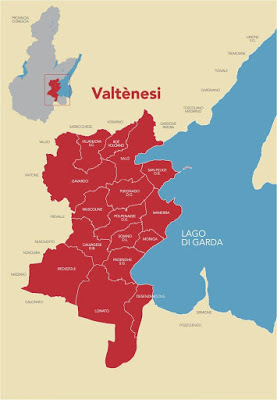 |
| Map of Valténesi Photo Credit: Consorzio Valténesi |
*It should be noted that there is a Chiaretto DOC and a Bardolino DOC, as well as a Valtenèsi and Valtènesi Chiaretto DOC, which will all be discussed in another post.
The Lake Affect
Location, location, location. Ahh, we are all familiar with those three important words when it comes to buying, selling and producing. Well, location absolutely plays a role in the production of Chiaretto, as well as the other wines surrounding Lake Garda.
Lake Garda, (formerly referred to Romans as Lake Benacus, due to a historic battle fought there by Roman Emperor Claudius II) Italy’s largest lake and shoreline, spans the provinces Verona in the southeast, Brescia to the southwest, and Trentino in the north. Lake Garda was created by a massive piedmont glacier flowing down from the Dolomite mountains during the Ice Age period. This is responsible for the region’s unique Mediterranean micro-climate. According to Visit Garda, “The Garda area boasts all the characteristics of a “pre-alpine zero-thermal oasis”. It is a sub-Mediterranean climate, so mild and different from the other lakes.” The air and water temperatures in Garda are typically warmer in the winter and cooler in the summer. Therefore, the mild and temperate Lake Garda climate conditions the region, making it conducive and optimal for citrus lemon trees, olive trees and viticulture.
 |
| Shores of Lake Garda, near Monte Baldo |
I can certainly attest to the moderate Garda climate and its impact on the viticulture and agriculture. I remember the warm lake breezes and the beautiful fauna and flora. In fact, on my recent visit, I was able to visit Torri del Benaco in Lake Garda, the home to the ancient Lemon Garden. This lemon garden exists right in the middle of the mountains! At Torri del Benaco, their lemon production is so broad that they even make lemoncello and export lemons to Germany and Russia. The temperature is moderate to the point that lemons grown all year round. Beautiful pristine waters of Lake Garda reflect the sun, thereby, keeping the temperature relatively warm and moderate.
 |
| Pink Limestone Slabs in Lake Garda |
Lastly, the Garda mountains, also known as the Garda Hills, lead to beautiful high altitude winds. The winds descend from the mountains in the morning and go back to the mountains in the afternoon. The mountain climate is usually mild due to the Mediterranean Sea, and snowfall is a rarity. Therefore, only a few of the mountains are used for skiing and winter sports. Instead, the focus in the Garda Hills is on water sports, hiking and mountain biking due to its temperate climate. I was able to see visit of the Garda Hills, Monte Baldo, which is a mountain range in the Italian Alps, located in the provinces of Trento and Verona. Monte Baldo is known as the Europe Botanic Garden for its biodiversity. The combination of the mountain winds, lake breezes and fantastic soil ensures that the Corvina and Rondinella grapes are more fruity, and perfect for the production of rose and other wines. It can be said that chiaretto is, in fact, a mountain wine.
Check out our short clip of Lake Garda. Feel the breeze and smell the soil.
The ‘Lake Effect’ via the warm breezes, Mediterranean climate and moronic soil is responsible for Chiaretto’s remarkable freshness, and in fact, tremendously enhances and influences everything in the Lake Garda basin. This applies to Bardolino in the east, Valtenesi in the west and all areas surround Lake Garda.
 |
| Lake Garda, with views of Monte Baldo |
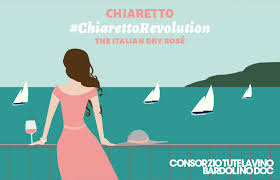 |
| Photo Credit: Consorzio Tutela Vino Bardolino DOC |
More articles will be posted regarding the shining producers of Chiaretto di Bardolino. Meanwhile, read about our Pregaming and Preparing to Plunge into Chiaretto.
Learn more about the Corvina grape, as we Uncover Corvina with Vigneti Villabella
Subscribe and check back to read more about Chiaretto, the lesser known, but impressive rosé wine from Bardolino Italy.
